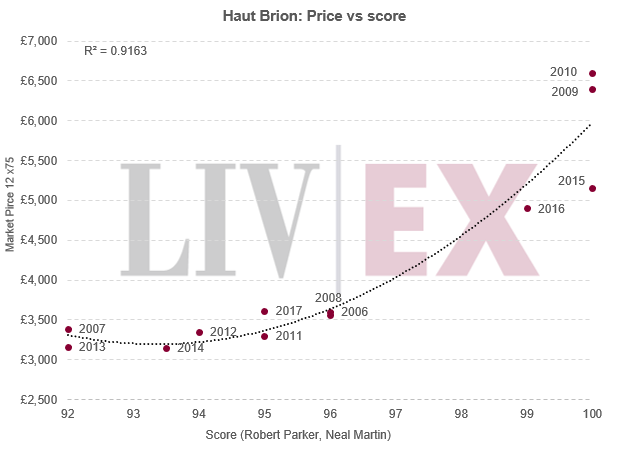Liv-ex’s ‘Fair Value’ methodology represents a useful approach to pricing wines. It uses regression analysis to measure the relationship between price and quality and establish the fair price of a wine based on its critic score and vintages already available in the market. Where there is a correlation (R-squared) between the scores and prices of over 50%, the trend line suggests a wine’s ‘Fair Value’.
R-squared value (0% to 100%) measures how close the data points are to the fitted regression line. In general, the higher the R-squared, the better the regression line (or ‘trend line’) fits the data. In statistical terms, the R-squared measures how much of the variation in price can be explained by variations in score. For example, as the chart below shows, Haut Brion’s prices have historically shown a very strong correlation (91%) to scores from Robert Parker (2006-2012) and Neal Martin (2013-2017).

‘Fair Value’ is a more rigorous way of assessing the price of a wine rather than the antiquated focus on year-on-year price change. For instance, a wine can go up in price from the previous year and still be undervalued if its quality is markedly better. We hypothesise that, over time, wines will tend toward their ‘Fair Value’ price. Typically, though not always, the most ‘undervalued’ wines provide the best returns as the price moves up to ‘Fair Value’ in the secondary market, whereas ‘overvalued’ wines provide the worst return. This is explored in more detail in our report, Bordeaux 2018 – Keenly poised, which will be published tomorrow.
Who determines the quality? Introducing ‘Benchmark Critic’
This year, our En Primeur charts will show scores from Robert Parker (vintages 2005-2012), Neal Martin (vintages 2013-2017) and scores from Lisa Perrotti-Brown, Antonio Galloni and James Suckling for the 2018 vintage. The reasons for this are explained below.
Robert Parker, who retired from tasting En Primeur in 2015, was undoubtedly the critic with the greatest influence on Bordeaux prices. His scores for vintages pre-2012 still show the closest correlation to Liv-ex Market Prices, even though many of these wines were later re-tasted (and re-assessed) by other critics.
According to the results of a recently conducted survey by Liv-ex, Neal Martin – Parker’s nominated successor – has been the preferred wine critic by our merchant members since Parker’s retirement. However, Martin will not be tasting the Bordeaux 2018 vintage in April this year due to a medical condition. We will use his scores (published on Wine Advocate and Vinous) as a marker of quality for vintages between 2013-2017.
For this year’s release, we will use scores from Lisa Perrotti-Brown, Antonio Galloni and James Suckling. Each of these critics have demonstrated an ability to move the market. Liv-ex members can find individual scores and correlations to release prices on our Bordeaux 2018 analysis tool.
Our ‘Benchmark Critic’ series therefore considers both the perpetual influence of Parker and the changing face of wine criticism. Its aim is to simplify the price setting process for the 2018 vintage, at a time when buyers and sellers might be uncertain which critics to follow.
In order to give a broad and balanced context for understanding new releases, we will also refer to the opinions of other key critics such as Jane Anson, Jancis Robinson and James Molesworth in our blog posts.
How to price En Primeur using ‘Fair Value’?
Our analysis can be used to approximate the ‘Fair Value’ of a wine by looking at the price implied by the trend line, based on its score. However, it is expected that En Primeur releases should be priced at discounts to the trend line as buying En Primeur tends to carry more risk than buying wines that are physically available in the market.
For some wines, age has a greater influence on price than score. This may be because buyers are seeking exposure to a particular brand and are prepared to pay a premium based on age. Prices for Beychevelle, for example, are more closely correlated to their age (70%) than their score (23%), suggesting that age is the key influencer of price.
Follow our analysis
Throughout the campaign, we will be blogging all the major releases on Liv-ex Insights. You can also view key critic scores here and key prices here.
To keep up-to-date, follow us on Twitter and subscribe to our weekly blog email below.
[mc4wp_form id=”18204″]



